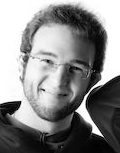"The fundamental problem of cellular medicine: More is different"
Consider a chemotactic cell. The cell's motility is derived from a motile actin network - constant polymerization and protrusion and debranching and depolymerization. Not enough is known about the "strokes" of the motility engine - that is to say, how filaments are organized to drive in a particular direction.
Well, take an ActA-coated polystyrene bead and expose it to a solution of the Arp2/3 complex and the capping protein. For reasons that were explained but that I can't paraphrase, if one adds the right tag molecules, one can observe a filamentous shell nucleate around the bead, grow uniformly, and then suddenly rupture and concentrate around one area of the bead. The resulting disequilibrium forces the bead to move off in a particular area.
The plasmid R1 par operon is a 3 component system. ParM is a prokaryotic protein, so it could potentially be used in a eukaryote without dire side effects, and the operon inherently doesn't have a bunch of regulatory elements.
I had difficulty following all the elements of this talk. There were some fanatastic movies involved, and therefore you would gain so much more by watching the presentation. I'll try and beef this up later.
Saturday, May 20, 2006
Subscribe to:
Post Comments (Atom)

No comments:
Post a Comment